Speaker
Antonio Ferreira da SIlva
Description
In view of the g-factor tuning for spin manipulation in
semiconductor nanostructures, the electron effective
g-factor in GaAs and other III-V semiconductor quantum wells
(QWs) (g*QW) have been much investigated; however, for
example, the basic anisotropy Δg*QW (i.e. the difference
between in-plane and perpendicular g*QW) is still not well
understood. Such anisotropy was predicted by Ivchenko and
Kiselev [1] and observed with spin quantum beat measurements
[2, 3]; but in the well width dependence there is not yet a
very good agreement between theory and experiment.
We present a simple and accurate expression and show different results for the effective electron g-factor in III-V symmetric QWs in good agreement with the experiments. The theory uses standard envelope function approximation based on [4] and represents an alternative solution with respect to that by Ivchenko and Kiselev [1]. The quantum confinement effects in g*QW are easily understood and in particular the anisotropy Δg*QW is shown to be given by a mesoscopic interface spin-orbit (SO) contribution, as the Rashba one.
An effective Hamiltonian for the conducting electrons in the QW plus an external magnetic field is introduced in which the Rashba and the effective Zeeman terms appear on an equal footing. The expression for the band-edge g*QW (as a function of the well width, plus the band off-set and the bulk parameters in the Kane model) is then easily obtained with first-order perturbation theory.
The extension of the theory to general structures is also discussed. The obtained effective Hamiltonian and expression for g*QW should be of help in the electron g-factor tuning, and in other spintronic problems.
[1] E. L. Ivchenko and A. A. Kiselev, Sov. Phys. Semicond. 26, 827 (1992).
[2] P. Le Jeune et al., Semicond. Sci. Technol. 12, 380 (1997).
[3] A. Malinowski and R. T. Harley, Phys. Rev. B 62, 2051 (2000).
[4] E. de Andrada e Silva, G. La Rocca, and F. Bassani, Phys. Rev. B 55, 16293 (1997).
We present a simple and accurate expression and show different results for the effective electron g-factor in III-V symmetric QWs in good agreement with the experiments. The theory uses standard envelope function approximation based on [4] and represents an alternative solution with respect to that by Ivchenko and Kiselev [1]. The quantum confinement effects in g*QW are easily understood and in particular the anisotropy Δg*QW is shown to be given by a mesoscopic interface spin-orbit (SO) contribution, as the Rashba one.
An effective Hamiltonian for the conducting electrons in the QW plus an external magnetic field is introduced in which the Rashba and the effective Zeeman terms appear on an equal footing. The expression for the band-edge g*QW (as a function of the well width, plus the band off-set and the bulk parameters in the Kane model) is then easily obtained with first-order perturbation theory.
The extension of the theory to general structures is also discussed. The obtained effective Hamiltonian and expression for g*QW should be of help in the electron g-factor tuning, and in other spintronic problems.
[1] E. L. Ivchenko and A. A. Kiselev, Sov. Phys. Semicond. 26, 827 (1992).
[2] P. Le Jeune et al., Semicond. Sci. Technol. 12, 380 (1997).
[3] A. Malinowski and R. T. Harley, Phys. Rev. B 62, 2051 (2000).
[4] E. de Andrada e Silva, G. La Rocca, and F. Bassani, Phys. Rev. B 55, 16293 (1997).

